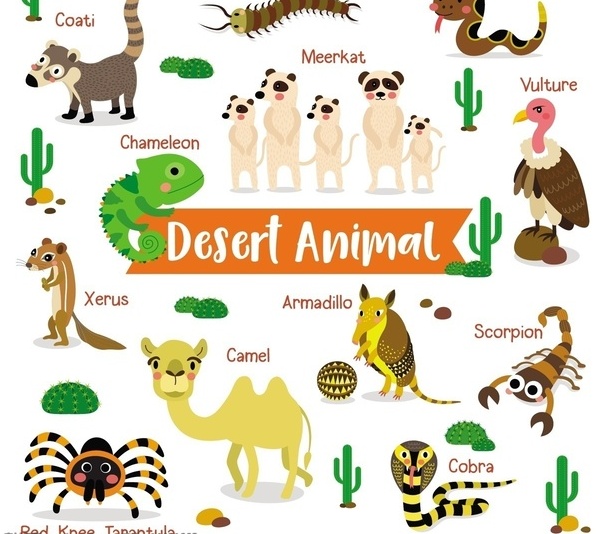Deserts are some of the most extreme environments on Earth, characterized by scorching temperatures during the day, freezing temperatures at night, and a severe lack of water. Despite these harsh conditions, many animals have evolved incredible adaptations to not only survive but thrive in the desert. In this article, we'll explore the fascinating physical and behavioral adaptations that enable animals to live in such an unforgiving landscape.

One of the most critical adaptations for desert animals is their ability to conserve water. Since deserts often go long periods without rain, animals must find ways to minimize water loss and maximize water retention.
The kangaroo rat is a small rodent found in the deserts of North America. These animals have evolved the remarkable ability to survive without drinking water at all. Instead, they obtain all the moisture they need from the seeds they eat, which are metabolized in their bodies to produce water. Additionally, kangaroo rats have highly efficient kidneys that produce very concentrated urine, minimizing water loss.
Camels are famous for their ability to endure long periods without water, a critical adaptation for desert survival. They can drink up to 40 gallons of water in one sitting and store it in their bloodstream, not in their humps as is commonly believed. Their humps store fat, which can be metabolized to provide both energy and water. Camels also have the ability to close their nostrils and conserve moisture through minimized sweating, making them perfect for arid environments.
Another essential adaptation for desert animals is the ability to regulate body temperature in the extreme heat. Without shade or water to cool off, many desert animals have developed ways to avoid overheating.
The fennec fox, native to the Sahara Desert, has several features that help it stay cool. Its large ears serve a dual purpose: they help dissipate heat and improve hearing. The fennec fox's pale fur reflects sunlight, and it is nocturnal, meaning it remains inactive during the hottest parts of the day and only hunts at night when temperatures are cooler.
The addax antelope, a rare desert-dwelling species, has light-colored fur that helps reflect the sun’s rays. It also minimizes its water needs by lowering its metabolic rate during the hottest part of the day, reducing the need for water and food. Like many desert animals, the addax rests during the day and is more active at night.
Many desert animals have adapted by becoming nocturnal, meaning they are active at night and rest during the day. By avoiding the intense heat of the desert sun, they can conserve energy and reduce water loss.
The desert hedgehog is primarily nocturnal, sleeping in burrows during the day to avoid the heat. At night, it emerges to hunt for insects and small creatures, taking advantage of the cooler temperatures. This behavioral adaptation allows it to conserve energy and moisture.
scorpions.html">Scorpions are another nocturnal desert dweller. During the day, they hide in burrows or under rocks, and at night, they become active, hunting for prey. Their ability to glow under UV light also helps them stay hidden from predators.
Navigating the hot, loose sand of the desert is a challenge for many animals, but some have developed unique ways to move efficiently in this environment.
The sidewinder snake is known for its unique "sidewinding" motion, which minimizes its contact with the hot desert surface. By moving sideways, the snake touches the ground with only two points of its body at a time, reducing the amount of heat absorbed from the sand. This adaptation allows the sidewinder to move quickly and efficiently across the desert without overheating.
The dromedary camel has long legs and wide, cushioned feet that help it walk easily on hot, shifting sand. Its feet are spread out to prevent it from sinking into the sand, and the camel's height keeps its body further from the heat radiating from the ground. These adaptations allow camels to travel long distances across the desert with minimal energy expenditure.
Another common adaptation among desert animals is burrowing. By digging into the ground, animals can escape the extreme temperatures of the desert surface and create a cooler, more stable environment to live in.
In addition to its water-saving adaptations, Merriam’s kangaroo rat digs deep burrows to stay cool during the day. These burrows provide a cooler, more humid microclimate, protecting the kangaroo rat from the scorching heat of the desert sun.
The desert tortoise spends much of its life in underground burrows. These burrows help regulate its body temperature and protect it from both the extreme heat of the day and the cold of the night. By staying underground, the tortoise reduces its exposure to the harsh desert environment.
In a desert, food can be scarce. Many desert animals have developed special diets or eating habits to cope with the lack of vegetation and prey.
The oryx is an antelope species that survives on tough, dry vegetation that many other animals cannot digest. Its digestive system is specially adapted to extract moisture from dry grasses and plants, allowing it to go for extended periods without drinking water.
The bearded dragon, a desert-dwelling lizard, is an omnivore that can eat a wide variety of foods, from insects to plants. This dietary flexibility allows it to survive in an environment where food sources may vary from season to season.
Desert animals have evolved a remarkable array of adaptations to survive in one of the most challenging environments on Earth. Whether it’s conserving water, regulating body temperature, becoming nocturnal, or burrowing underground, these adaptations showcase the incredible ingenuity of nature. Each species has developed its own unique strategies to thrive in the harsh, arid landscapes of the desert, proving that life can flourish even in the most extreme conditions.
animal tags: Desert
We created this article in conjunction with AI technology, then made sure it was fact-checked and edited by a Animals Top editor.